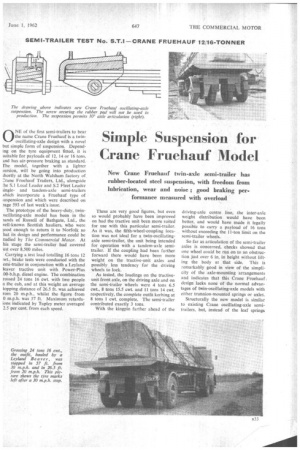Simple Suspension for Crane Fruehauf Model
Page 101

Page 102

If you've noticed an error in this article please click here to report it so we can fix it.
0 NE of the first semi-trailers to bear the name Crane Fruehauf is a twinoscillating-axle design with a novel but simple form of suspension. Depending on the tyre equipment fitted, it is suitable for payloads of 12, 14 or 16 tons. Ind has air-pressure braking as standard. The model, together with a lighter version, will be going into production shortly at the North Walsham factory of :ram Fruehauf Trailers, Ltd., alongside he S.1 Load Leader and S.2 Fleet Leader ;ingleand tandem-axle semi-trailers which incorporate a Fruehauf type of ;uspension and which were described on )age 593 of last week's issue.
The prototype of the heavy-duty, twinmcillating-axle model has been in the sands of Russell of Bathgate, Ltd., the veil-known Scottish hauliers, who were ;ood enough to return it to Norfolk so hat its design and performance could be tudied by The Commercial Motor. At his stage the semi-trailer had covered ust over 8,500 miles.
Carrying a test load totalling 16 tons 12 :wt., brake tests were conducted with the emi-trailer in conjunction with a Leyland leaver tractive unit with Power-Plus ,00-b.h.p. diesel engine. The combination rossed 24 tons 16 cwt. with two people a the cab, and at this weight an average topping distance of 26.5 ft. was achieved rom 20 m.p.h., whilst the figure from 0 m.p.h. was 57 ft. Maximum retarda.ions indicated by Tapley meter averaged 2.5 per cent, from each speed. These are very good 'figures, but even so would probably have been improved on had the tractive unit been more suited for use with this particular semi-trailer. As it was, the fifth-wheel-coupling location was not ideal for a twin-oscillatingaxle semi-trailer, the unit being intended for operation with a tandem-axle semitrailer. If the coupling had been farther forward there would have been more weight on the tractive-unit axles and possibly less tendency for the driving wheels to lock.
As tested, the loadings on the tractiveunit front axle, on the driving axle and on the semi-trailer wheels were 4 tons 6.5 cwt., 8 tons 15.5 evvt. and 11 tons 14 cwt. respectively, the complete outfit kerbing at 8 tons 1 cwt. complete. The semi-trailer contributed exactly 3 tons.
With the kingpin farther ahead of the driving-axle centre line, the inter-axle weight distribution would have been better, and would have made it legally possible to carry a payload of 16 tons without exceeding the 11-ton limit on the semi-trailer wheels.
So far as articulation of the semi-trailer axles is concerned, checks showed that one wheel could be run on to an obstruction just over 6 in. in height without lifting the body at that side. This is remarkably good in view of the simplicity of the axle-mounting arrangements and indicates that this Crane Fruehauf design lacks none of the normal advantages of twin-oscillating-axle models with either trunnion-mounted springs or axles.
Structurally the new model is similar to existing Crane oscillating-axle semitrailers, but, instead of the leaf springs being carried in phosphor-bronze trunnion bushes at each end, there are rubber pads above the spring ends, with barrelshaped rubber bushes beneath the springs. The top three leaves are sandwiched between the rubber components at each end.
An angular deflection of 10° is permitted, and there is no sliding contact between the spring leaves and the rubbers. All movement is accommodated within the pads themselves.
This principle is not in itself new, having been applied to very much larger trailers manufactured by Cranes, but it is the first time that it has been used on designs of this size. The springs are 3.5-in wide and originally the rubber pads were to be held in place by screws (as seen in the accompanying drawing). Production versions, however, will not have these screws, the pads being moulded to include a locating pip on top, with further location provided by turn-down edges to the mounting brackets. No lubrication is necessary and suspension wear should be negligible.
Similarly, the hanger brackets of the prototype are carried on a sub-frame which is welded to the main framing members. Weight will be saved in production by attaching extended versions of these brackets directly to the main frame, whilst weight can be reduced further by using a pressed-steel main frame in place of the rolled-steel members of the type
tested. The subsequent total weight saving will then be about 10 cwt.
Girling S-cam brakes are employed, the four 15.5-in. x 4.25-in, units giving a total frictional area of 512 sq. in. (the total area of the brake linings of the tractive unit used for the test was 623 sq. in.). Each pair of brakes is actuated by a Bendix Westinghouse 24-sq.-in, diaphragm unit working on a standard Bendix adjustor. A handwheel-type parking brake is provided.
The effectiveness of the semi-trailer brakes by themselves was shown by the ability to achieve an efficiency of 28 per cent, when these were applied from 20 m.p.h. by use of the hand reaction valve
in the tractive-unit cab. J.F.M.






































































































































































